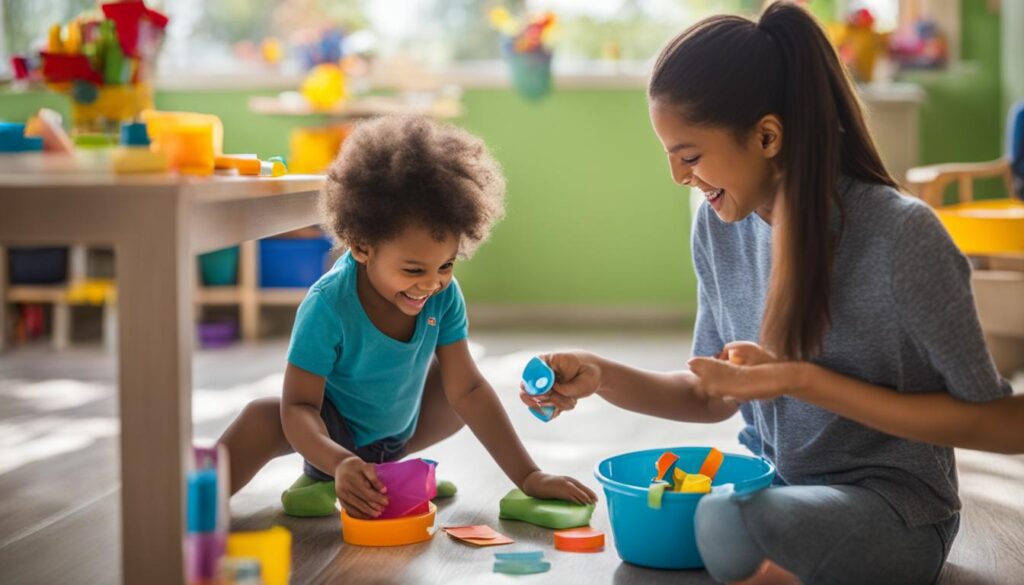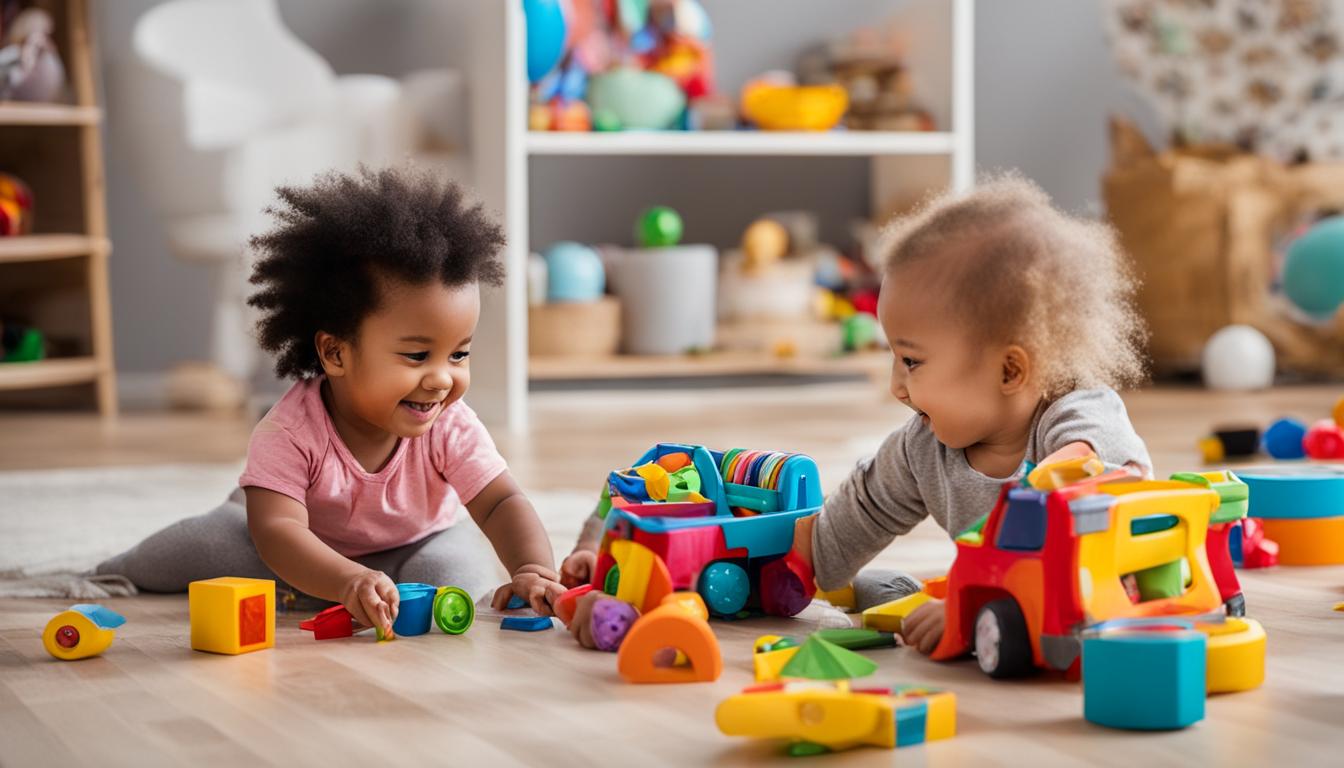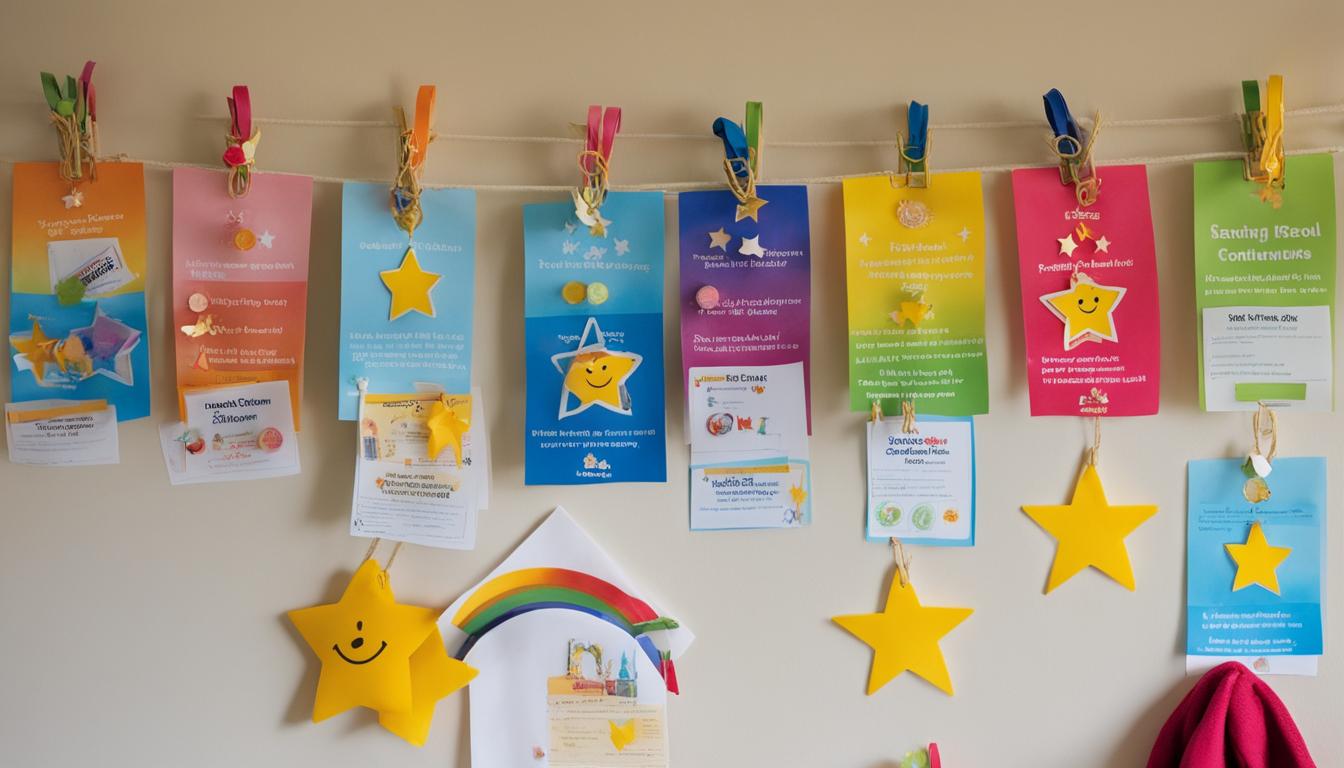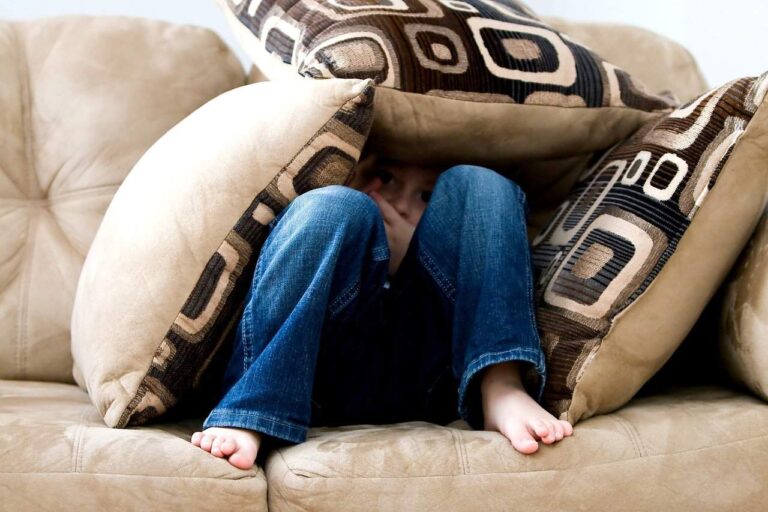Boosting Good Behavior: Techniques for Reinforcing Positive Actions in Toddlers
As parents, it’s essential for us to discover ways not just to redirect our little ones when they step out of line, but to actively encourage behaviors that we desire to see flourish. The concept isn’t new, but mastering the techniques for reinforcing positive actions in toddlers is as vital today as it’s ever been. Not only does applying positive reinforcement strategies for toddlers affirm the actions we appreciate, but it also builds trust and strengthens bonds. In my journey, I’ve found that by boosting toddler behavior with reinforcement, children glow under the light of attention given to their wins, no matter how small.
One of the most essential components of positive reinforcement is immediate acknowledgement. The time between action and reward is pivotal; the shorter it is, the stronger the association. Clapping and offering a verbal “well done!” when my toddler shares a toy or waits patiently, fortifies the good deed in their memory. It’s a simple gesture that makes a lasting impact.
For those who have faced the daily parental challenge of inspiring their young ones to follow rules or manage their emotions, I’ve discovered that persistence and creativity in encouragement have proven effective. Without a doubt, positive reinforcement isn’t just about preventing negative behaviors—it’s also about incentivizing the positive ones, nurturing an environment where proactive and kind behavior is the norm.
Skip To The Following Sections
- The Power of Positive Reinforcement in Early Childhood
- Strategies for Promoting Positive Actions in Young Kids
- Encouraging Positive Behavior in Young Children Through Consistency
- Nurturing Positive Habits in Toddlers with Effective Parental Techniques
- FAQ
- What are some techniques for reinforcing positive actions in toddlers?
- How does positive reinforcement in early childhood support a child’s development?
- Why is emphasizing praise over punishment important in promoting positive actions in young kids?
- How can creative reward systems sustain good behavior in toddlers?
- What is the significance of recognizing and celebrating small victories in toddler behavior?
- How does consistency in reinforcement strategies encourage positive behavior in young children?
- In what ways does role modeling affect a toddler’s behavior?
- How can creating an environment conducive to positive actions influence toddler behavior?
- Source Links
Key Takeaways
- Positive reinforcement encourages prosocial behaviors and can prevent misbehavior in toddlers.
- Rewards for desired actions should be immediate and can be as simple as clapping and verbal praise.
- Consistent application of positive reinforcement strategies is crucial in making a behavior become habitual.
- Recognizing effort and improvement, not just perfect outcomes, is key to boosting toddler behavior.
- Creativity in reward systems and consistency in praise play significant roles in nurturing a child’s willingness to maintain good behavior.
- Parental patience and the use of affirming language can create a positive atmosphere for behavior reinforcement.
The Power of Positive Reinforcement in Early Childhood
As I delve into my understanding of what shapes the foundation of a child’s life, I have embraced the concept of positive reinforcement in early childhood. This method stands as a cornerstone within positive discipline, offering us as parents and educators a reliable tool for encouraging positive behavior in young children. Through its application, we’re not merely addressing what needs to change but actively
Of all the gems I’ve gathered on this parenting journey, the truth that has resonated with me most profoundly is that reinforcing the positive aspects of a child’s actions outweighs the focus on their mistakes or misbehavior. It’s this pivot towards understanding and endorsing fostering good toddler behavior that forms patterns which ultimately become lifelong habits.
- The inclusive nature of positive reinforcement involves a myriad of interactions – from a kind smile for a small act of sharing to a celebratory cheer for a job well done.
- Consistently catching and accentuating the positive embeds in children a sense of accomplishment and the desire to replicate those praised actions.
- My aim has always been to cultivate an environment where kindness, consistency, and encouragement are the pillars that sustain my child’s developing comportment.
But let’s talk specifics. Take limit-setting, an aspect of positive reinforcement that could be as straightforward as establishing a bedtime routine. It’s impressive how a simple association, like reading a favorite story followed by lights out, reinforces the desired behavior night after night. Consistency here is key; it assures your child knows what’s expected and that following through results in a favorable outcome.

When praise and recognition are infused with genuine warmth, children begin to internalize these positive experiences.
“Yes, you did a great job picking up your toys without being asked!”
This sentence isn’t just a string of words, it’s an affirmation that the child’s contribution is meaningful and noteworthy.
It’s also critical to highlight and reward efforts, not just pinpoint achievements. This method nudges children beyond the bounds of perfection and frees them to explore and engage in tasks with a courageous heart. Just the other day, my child attempted to tie their shoelaces. They weren’t perfect loops, but the endeavor was praiseworthy – a direct reflection of their autonomy budding through persistent trials.
Indeed, laying the groundwork for positive behavior requires a parental vision that views each day as a tapestry of teaching moments. It’s about seizing those instances where I can say, “I saw you share your snack with your friend. That was very kind of you,” thereby fostering good toddler behavior that echoes into the realm of social consciousness.
To sum up, the power packed within positive reinforcement is immense and enduring. It’s through this compassionate lens that I approach every step of my child’s developmental path, knowing well the profound impact my encouragement has on their future.
Strategies for Promoting Positive Actions in Young Kids
As I reflect on the journey of nurturing my young one’s growth, I’ve come to appreciate the subtlety and strength of positive reinforcement. In the developing tapestry of my child’s behaviors, I’ve honed in on a selection of approaches that scaffold their ability to choose good behavior time and again.
Emphasizing Praise Over Punishment
I’ve learned that shining a spotlight on my child’s appropriate actions rather than dwelling on the negatives fosters a richer, more positive home environment. This ethos is at the heart of my strategies for promoting positive actions in young kids. It’s about showering them with praise for the efforts they make, no matter how small, and encouraging every step towards improvement. For instance, if my toddler makes an attempt to put away their toys, even if it’s not perfectly executed, my immediate validation of their effort is key. This doesn’t mean that there’s no place for setting boundaries or correcting behavior, but it ensures that the scales are tipped towards celebrating the positive.
This nurturing of positive habits in young children is foundational, telling them that their actions are seen, valued, and appreciated, thus setting the stage for those behaviors to flourish and become habitual.
Creative Reward Systems for Sustained Good Behavior
In our household, we have found joy and success in implementing creative reward systems. Whether it’s stickers that fill a chart or tokens that can be traded for a larger reward, these systems have become a visual and tangible representation of my child’s achievements. Mind you, these aren’t bribes, but affirmations that what they’re doing is meaningful and leads to positive outcomes.
Moreover, aligning these rewards with the actions I aim to promote — say, additional storytime for sharing toys without fuss — embeds the behavior more deeply. It is these sustainable good behavior practices that assist in transforming occasional good deeds into steadfast habits.
Recognizing and Celebrating Small Victories
The art of recognizing small victories has become a critical component of my approach. Each time my child successfully executes even the simplest task — like saying ‘please’ or ‘thank you’, or sitting through a meal without complaint — I’m there with a high-five or a hearty “Well done!”. This frequent and enthusiastic acknowledgment not only buoys their spirits but also incentivizes them to continue on this positive trajectory.
“That was such a kind way to share your toys,” I might say, or,
“Wow, you tied your shoes all by yourself today!”
These moments, though fleeting, accumulate significant weight in
promoting positive actions in toddlers.
In sum, these varied strategies — from the cheering of endeavors to the thoughtful design of reward systems — have proven indispensable. They are the tools by which I cultivate the tiny seeds of today into the strong, enduring trees of tomorrow’s character and disposition.
And so, with a watchful eye for those instances worthy of cheer and reinforcement, I navigate the days, confident in the power of these techniques to both inspire and shape. After all, isn’t it the smallest pebbles that ripple the vastest waters?
Encouraging Positive Behavior in Young Children Through Consistency
In my personal journey as a parent, I’ve found that one of the most effective means of encouraging positive behavior in young children is through the steadfast application of consistent positive reinforcement. Like threads in a tapestry, the repeated patterns of affirmation and acknowledgment weave a strong fabric of behavior. As any intricate design requires steady hands, so too does the nurturing of a child’s actions demand consistent positive reinforcement. As adults are compelled to meet their professional goals for the assurance of a paycheck, children, similarly, thrive when positive feedback punctuates their actions regularly.
Just as a gardener tends to their plants daily, so must we attend to the budding behaviors of our little ones with regular care and attention.
It’s this regularity—that gentle rain of praise—that saturates the soil of a child’s growing world, allowing the seeds of good deeds to sprout and bloom. My approach has always been to cheer the small victories, even as simple as offering a supportive nod for a task attempted. This cultivates an environment in which positive behavior is not just encouraged but expected and regarded as the norm within their developmental journey.

The notion of effective toddler behavior techniques is one steeped in assurance and predictability. Knowing that good behavior is not only respected but rewarded, children learn to adopt these behaviors more readily. In my experience, it’s the mixture of immediate and intermittent reinforcements that solidifies these efforts. An immediate hug after a successful attempt at sharing toys, a special word of praise when cooperation is exhibited at playtime—all these instances construct a positive pathway for my child.
- Immediate rewards foster a robust connection between good behavior and positive outcomes.
- Recognizing and acknowledging even the smallest efforts can have an outsized impact on promoting desirable behaviors.
- Patience and a keen eye for observing positive actions are quintessential tools in a parent’s repertoire for nurturing positive development.
Moreover, as intervals grow between these reinforcements, I’ve learned that the previously established behaviors remain sturdy. The sporadic “well done!” or an unexpected extra bedtime story for continuous politeness during the day acts as a delightful surprise that reinforces the consistency of positive actions already ingrained.
To me, the key has always been the balance—keen observation to catch those opportunities for praise, coupled with a reliable rhythm of encouragement and reward. It’s through this lens of empathy, strategy, and persistence that I contribute daily to the tapestry of my child’s character—an artwork of dispositions shaped with love and consistent positive reinforcement.
Nurturing Positive Habits in Toddlers with Effective Parental Techniques
In my role as a guide and caregiver, I’ve seen firsthand the profound effect of effective parental techniques on nurturing positive habits in toddlers. One of the most impactful methods is through role modeling. By consciously displaying the behavior I hope to instill in my child, I am providing a constant, living example of how to act. When I express gratitude, demonstrate patience, or navigate disputes calmly, I am teaching these values more powerfully than any words could. My behavior becomes a mirror in which my child can see the positive impact of actions and etiquette.
Alongside leading by example, I give much thought to creating conducive environments that naturally promote positive toddler actions. A space where my child feels safe to explore and play is a space where they are more likely to practice kindness, sharing, and self-regulation. This doesn’t just mean child-proofing to prevent accidents, but also organizing our home to foster creativity, cooperation, and independence. By streamlining our living area to remove unnecessary temptations and distractions, I am setting the stage for positive habits to emerge and thrive.
Finally, it’s about the subtle nature of parental support techniques, where I choose to focus my attention and how I react to my child’s daily activities. By selectively ignoring minor missteps and instead pouring energy into celebrating victories, I concentrate on reinforcing the behaviors I want to see repeated. This strategic choice in where to direct my energy and approval has not just reduced friction in our daily interactions, but has fundamentally supported the development of my child’s character, nurturing a foundation rooted in positivity and good habits.
FAQ
What are some techniques for reinforcing positive actions in toddlers?
Techniques for reinforcing positive actions in toddlers include specific praise for desirable behaviors, setting up creative reward systems like sticker charts or token economies, and celebrating even the smallest achievements to encourage continued good behavior. Additionally, consistency in offering recognition and rewards is crucial for reinforcing these positive actions effectively.
How does positive reinforcement in early childhood support a child’s development?
Positive reinforcement in early childhood is vital for shaping a child’s behavior by encouraging the repetition of good actions. This technique, which rewards desirable behaviors instead of punishing undesired ones, helps children learn what actions are appreciated and expected. It fosters a sense of achievement and supports the development of positive long-term habits.
Why is emphasizing praise over punishment important in promoting positive actions in young kids?
Emphasizing praise over punishment is important in promoting positive actions because it encourages a child to engage in good behavior by recognizing and affirming their efforts. This positive feedback creates an encouraging environment that motivates children to repeat these actions, and it builds their self-esteem and confidence.
How can creative reward systems sustain good behavior in toddlers?
Creative reward systems, like sticker charts for younger children or token economies for older children, can sustain good behavior by providing a visible and tangible way for kids to track their progress. They allow for immediate positive reinforcement, which can later be exchanged for more considerable rewards, thus promoting and incentivizing continued good behavior.
What is the significance of recognizing and celebrating small victories in toddler behavior?
Recognizing and celebrating small victories is essential because it affirms a child’s progress and reinforces the value of their positive behavior. It helps build confidence and motivates them to strive for more successes, showing them that even incremental improvements are noteworthy and appreciated.
How does consistency in reinforcement strategies encourage positive behavior in young children?
Consistency in reinforcement strategies is key to encouraging positive behavior because it provides a reliable framework for children to understand the positive outcomes of their actions. Just like regular pay motivates adults to work, consistent recognition and rewards motivate children to maintain good behavior.
In what ways does role modeling affect a toddler’s behavior?
Role modeling significantly impacts a toddler’s behavior because children learn by imitating those around them, especially their parents. When parents exhibit positive behaviors such as kindness, patience, and good manners, they provide a powerful example for their children to emulate, thereby fostering similar behaviors in their kids.
How can creating an environment conducive to positive actions influence toddler behavior?
Creating an environment conducive to positive actions can greatly influence toddler behavior by minimizing the chances of misbehavior. An environment rich in stimuli and safe for exploration encourages positive engagement and learning, while structuring it to reduce potential issues can reinforce positive behaviors and reduce the need for correction.










